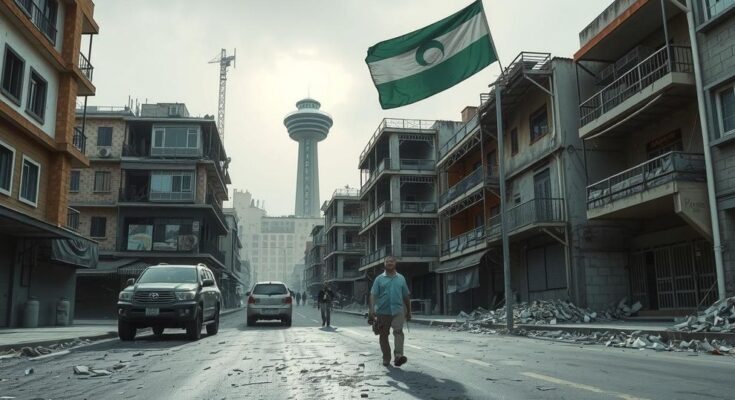Goma, eastern DRC, faces ongoing turmoil following the M23 group’s takeover. Three months on, violence and humanitarian issues prevail, with over 1.2 million displaced. Daily life is crippled, uncertainty reigns, and scars of war remain evident.
In Goma, eastern Democratic Republic of the Congo (DRC), life continues amidst the heavy shadows of recent conflict. The city, which once thrived beneath the formidable Mount Nyiragongo, is now marked by unrest following the March 23 Movement (M23) rebel group’s takeover earlier this year. Approximately three months post-occupation, the effects on daily life have been profoundly disruptive, as peace remains notably elusive for its over two million residents.
The M23 rebels advanced into Goma on January 27, claiming control and reminiscent of a similar incident from 2012. This has revived painful memories for the locals, who remember, all too well, the tumultuous fate of their city during previous conflicts. Residents faced heavy bombardment as fighting erupted, with residential areas becoming war zones. Government reports estimate that over 8,500 people died and nearly 5,600 were wounded during the conflict. Eyewitness accounts tell of harrowing losses, including pregnant women and newborns caught in the crossfire.
Despite a declared “humanitarian ceasefire” by M23 on February 4, violence has raged on, particularly affecting North and South Kivu provinces. M23’s momentum did not stop; they further seized Bukavu, the capital of South Kivu, solidifying a presence with fortified positions throughout the region. Political analysts express concern that this ongoing phase may become even more deeply rooted than those of the past. Corneille Nangaa, former electoral chief, asserted intentions to “liberate the entire country,” including the nation’s capital, Kinshasa.
The grim situation in Goma unfolded rapidly after the rebel group’s takeover. While gunfire subsided, chaos and oppression soon replaced the tension. Commercial activity has nearly vanished, owing to a collapsed banking system and cash shortages. Reports indicate that crime rates, particularly during nighttime, have surged as the absence of government structures allowed M23 to institute checkpoints and impose taxes backed by road tolls.
The humanitarian crisis continues to expand alarmingly. The International Organization for Migration recently estimated that over 1.2 million people had been newly displaced in Kivu since the onset of the conflict in January. Many former residents of Goma have been forced to flee once again, often left with nothing but what they could carry away. In early February, M23 demanded the evacuation of key displacement camps, resulting in families fleeing their makeshift homes almost overnight, only to return to villages that had been left in ruins.
Traveling 27 kilometers west of Goma, one encounters Sake, viewed as the last defensive line for Goma. The area has been the battleground for fierce clashes, leaving the town ravaged and the streets lined with memories of violence. Local residents like Christian Kabuya report ongoing dangers from unexploded ordnance, with several tragic accidents already claimed lives, including those of children.
At Ndosho Hospital, the last facility in Goma still treating the wounded, staff are overworked and facing tremendous strain. Supported by the International Committee of the Red Cross (ICRC), the hospital is overwhelmed with the sheer volume of injured individuals. ICRC veteran Taoffic Mohamed Toure noted the unique complexities the humanitarian effort faces amid the multitude of actors involved and ongoing violence. He remarked on the challenges posed to operations in eastern Congo, highlighting the delicate and precarious nature of the situation.
With diplomatic dialogues stalling and ceasefires disintegrating, the residents of eastern DRC remain ensnared in a web of conflict. For the people of Goma, with memories of former peace overshadowed by scars of war, the road to recovery seems painfully distant. As the lava of Mount Nyiragongo hardens into the landscape, the remnants of conflict stubbornly linger over the city—a stark reminder of the ongoing strife.
In conclusion, Goma in the eastern DRC is grappling with the aftermath of the recent takeover by the M23 rebel group. Despite attempts for a humanitarian ceasefire, violence persists, contributing to a humanitarian crisis with millions displaced. As local institutions weaken, the impact on daily life has been devastating, culminating in increased crime and chaos. The people of Goma continue to endure hardships in a landscape marred by conflict and loss, with the future uncertain.
Original Source: english.news.cn




